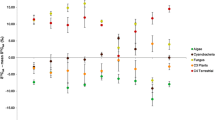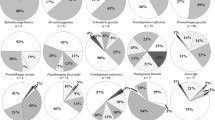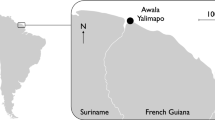Abstract
Menhaden are one of the most abundant components of fish communities in Gulf and Atlantic estuaries. Juvenile menhaden have been reported to have zooplankton, phytoplankton, andSpartina-derived detritus in their guts. However, there has been disagreement over the importance of the detritus as a food source. We show, using physiological and stable isotope evidence, that detritus can be used by juvenile Gulf menhaden. Their diet is very roughly 30% detritus- and 70% plankton-based.
Similar content being viewed by others
Literature cited
Cowey, C. B. andJ. R. Sargent. 1979. Nutrition, p. 1–69.In W. S. Hoar, D. J. Randall, and J. R. Brett (eds), Fish Physiology, Vol. VIII. Bioenergetics and Growth. Academic Press, New York.
Darnell, R. M. 1961. Trophic spectrum of an estuarine community based on studies of Lake Pontchartrain, Louisiana.Ecology 42:553–568.
Deegan, L. 1986. Changes in body composition and morphology of young-of-the-year Gulf menhaden,Brevoortia patronus Goode, in Fourleague Bay, Louisiana.J. Fish. Biol. 29: 403–415.
Haines, E. B. 1977. The origins of detritus in Georgia salt marsh estuaries.Oikos 29:254–260.
Hughes, E. H. andE. B. Scherr. 1983. Subtidal food webs in a Georgia estuary: δ13C analysis.J. Exp. Mar. Biol. Ecol. 67: 227–242.
Jeffries, H. P. 1975. Diets of juvenile Atlantic menhaden in three estuarine habitats as determined from fatty acid composition of gut contents.J. Fish. Res. Board Canada 32:587–592.
June, F. C. andF. T. Carlson. 1971. Food of young Atlantic menhaden,Brevoortia tyrannus, in relationship to metamorphosis.Fish. Bull., U.S. 68:1–20.
Kapoor, B. G., H. Smit, andI. A. Verighina. 1975. The alimentary canal and digestion in fishes.Adv. Mar. Biol. 13: 109–239.
Lee, R. F., J. C. Nevenzel, andG. A. Paffenhofer. 1971. Importance of wax esters and other lipids in the marine food chain: Phytoplankton and copepods.Mar. Biol. 9:99–108.
Lobel, P. S. 1981. Trophic biology of herbivorous reef fishes: Alimentary pH and digestive capabilities.J. Fish. Biol. 18:365–397.
Mayasich, S. A. andR. A. Smucker. 1987. Role ofCristispira sp. and other bacteria in the chitase and chitobiase activities of the crystalline style ofCrassostrea virginica (Gmelin).Microb. Ecol. 14:157–166.
Meyers, S. P., D. G. Ahern, S. K. Alexander, andW. L. Cook. 1975.Pichia spartinae, a dominant yeast of theSpartina salt marsh.Dev. Ind. Microbiol. 16:262–267.
Peters, D. S. andW. E. Schaaf. 1981. Food requirements and sources for juvenile Atlantic menhaden.Trans. Am. Fish Soc. 110:317–324.
Peterson, B. J. andB. Fry. 1987. Stable isotopes in ecosystem studies.Ann. Rev. Ecol. Syst. 18:293–320.
Peterson, B. J. andR. W. Howarth. 1987. Sulfur, carbon, and nitrogen used to trace organic matter flow in the saltmarsh estuaries of Sapelo Island, Georgia.Limnol. Oceanogr. 32:1195–1213.
Peterson, B. J., R. W. Howarth, andR. H. Garritt. 1985. Multiple stable isotopes used to trace the flow of organic matter in estuarine food webs.Science 227:1361–1363.
Prejs, A. andM. Blaszczyk. 1977. Relationships between food and cellulase activity in freshwater fishes.J. Fish. Biol. 11: 447–452.
Rosenberg, F. A. andL. Oberkotter. 1977. Methods for determining microbial biodeterioration in cellulose, p. 243–259.In A.H. Walters (ed.), Biodeterioration Investigation Techniques. Applied Sciences Publishers, London.
Stickney, R. R. andS. E. Shumway. 1974. Occurrence of cellulase activity in the stomachs of fishes.J. Fish. Biol. 6:779–790.
Suttkus, R. D. 1956. Early life history of the Gulf memhaden,Brevoortia patromus, in Louisiana.Trans. 21 Nat. Am Wildl. Conf. p. 390–407.
Tenore, K. R. 1983. What controls the availability of detritus derived from vascular plants: Organic nitrogen enrichments or caloric availability?.Mar. Ecol. Prog. Ser. 10:307–309.
Thayer, G. W., J. J. Govoni, andD. W. Connally. 1983. Stable carbon isotope ratios of the planktonic food web in the northern Gulf of Mexico.Bull. Mar. Sci. 33:247–256.
Valiela, I. 1984. Marine Ecological Processes. Springer-Verlag, New York. 546 p.
Author information
Authors and Affiliations
Rights and permissions
About this article
Cite this article
Deegan, L.A., Peterson, B.J. & Portier, R. Stable isotopes and cellulase activity as evidence for detritus as a food source for juvenile Gulf menhaden. Estuaries 13, 14–19 (1990). https://doi.org/10.2307/1351427
Received:
Accepted:
Issue Date:
DOI: https://doi.org/10.2307/1351427




